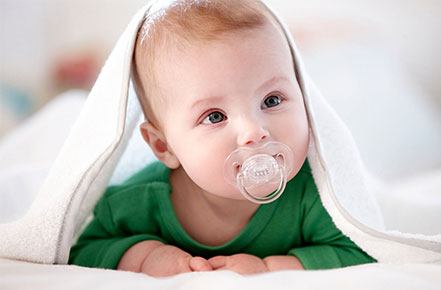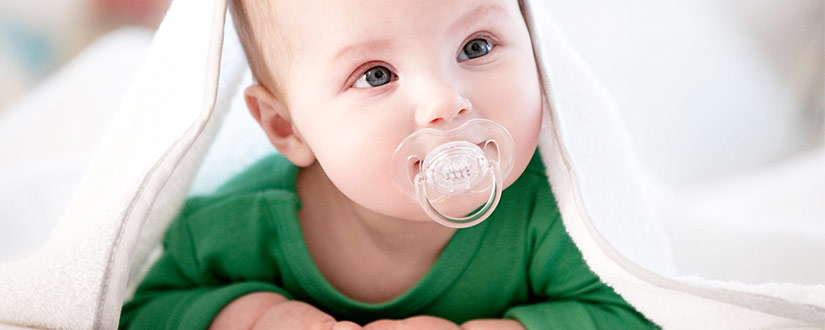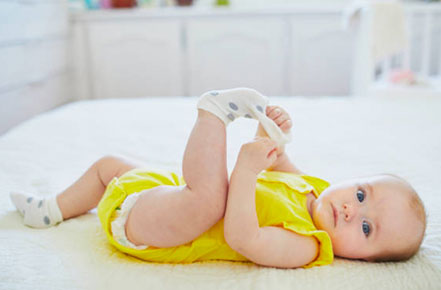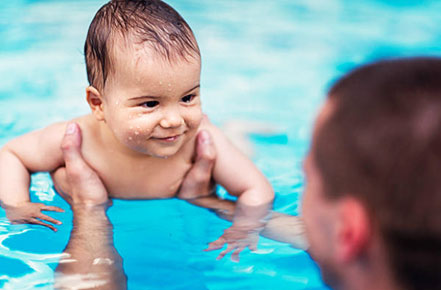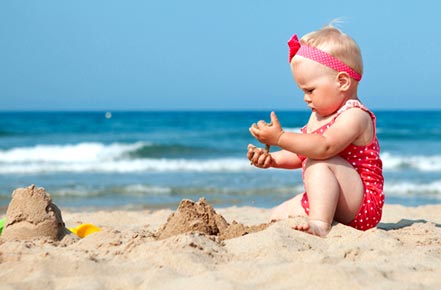As a new parent, there might be a million questions you have on your mind. A scary and a common one as well is, ‘My baby won’t take pacifier — what should I do?’ If you try to introduce it, there is another question that moms have ‘How to get a breastfeeding baby to take a bottle.’ If you look at both these problems, they have a similar pattern. Babies are born with a good sucking reflex. However, not all of them are efficient in this. This is where the struggle of ‘my baby doesn’t like pacifier’ begins.
Getting to know all about baby pacifier or babies dummy or binky, when to introduce them, how to get your babies to like them and other questions should make your work a tad bit simpler.
RIGHT TIME FOR INTRODUCING PACIFIER FOR BABIES
When can I give my baby a pacifier? – Based on the American Academy of Pediatrics, it is best to wait for at least 4 weeks before introducing a newborn baby pacifier. It will allow an infant to establish a good latch for breastfeeding. Giving a newborn a pacifier before latch is good, can lead to feeding issues. It is perfectly alright even if you wait for 6 weeks or more till you are confident about your breast milk supply and newborn’s feeding patterns.
Should you give a breastfed baby a pacifier? – Yes. You can give one to an infant irrespective of whether he is breastfed or bottle-fed. Ensure that your infant has established a good latch. Also, pick a suitable type that doesn’t lead to nipple confusion. Pacifier and breastfeeding should be balanced in such a way that feeding is not affected in the whole process.
It is never too late to introduce this comforter for babies. Even if you suddenly decide to try it after say the first year, it is an acceptable decision. Do not resort to using this too often. You can use it as a self-soothing tool for a child. It can pacify a baby when he/she is cranky, ill, or even suffers from some demanding situations for his/her age, like say, a long road trip.
HOW TO GET CHILD TO TAKE A PACIFIER?
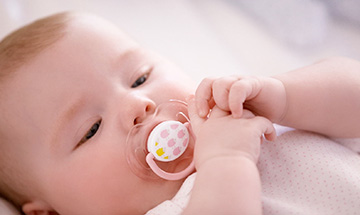
With many benefits of a pacifier for baby, there are several tips that parents follow to get their little one to like it. Follow these tips and you never say “My baby won’t take a pacifier”
- Do not force a child. It will only backfire and make him hate a binky even more. If your child is showing resistance, stop there and try at a different time. Sometimes if the baby sucks finger instead of a binky, it is alright to leave him to it. Reintroduce the dummy at night or when the little one drifts off to sleep.
- Try offering at the end of a feeding session. When a newborn has slowed down sucking the nipple, you can slowly replace it with the dummy. If he is already full and sleepy, he may not identify the difference.
- Try a binky with some breast milk smeared on it. It might kindle his interest of actually trying to suck on it rather than blatantly refusing it.
- If he doesn’t want a binky, give a few days gap after many failed attempts. Try again when the child is tired and sleepy. When not to give an infant, a binky matters more than when to give a baby pacifier. Avoid using it when an infant is cranky, especially if he has still not gotten used to it. Offering it during the critical periods can be reserved for later on when the child accepts his soother readily.
- If nothing else seems to work, try a different one. Shape or the material difference can go a long way in influencing the effectiveness of your trial.
WHAT TO DO IF MY BABY USING BREAST AS A PACIFIER
Another common problem when your baby doesn’t take pacifiers is looking for an alternative. It can be a finger, toy, or even your breast. It is hurting and uncomfortable for every mom, so only the one solution, in this case, can be getting baby to take pacifier. You can try MAM or Avent Pacifier, which imitate your breast relief.
HOW TO KEEP A DUMMY IN NEWBORN MOUTH?
Once a child has started liking his binky then comes one other big question — how do you keep it in place. Ask parents who wash a binky every 5 seconds to know what a struggle it can be. Once the little one grows up, he might drop his binky on purpose. He might find it funny or try to gain your attention by doing this. That is a different scenario to handle. Here are some tips to use if a dummy seems to be falling off of his mouth too often-

- A natural way to do it is to pull the soother when the little one is sucking it. It will make him establish a stronghold and make it less likely for it to fall off.
- Choosing the exact size and shape can also do the trick and prevent frequent falls from the mouth.
The first few days might be a struggle. Once an infant gets used to it, you will reach a stage where it is difficult to remove a dummy from his mouth rather than worry about it falling off.
CAN A CHILD SLEEP WITH A PACIFIER IN HIS/HER MOUTH?
Have you noticed newborns sleeping with pacifier peacefully and wondered whether you should let them be or take out the binky? Some parents are worried about possible pacifier teeth related damages. While some parents continue to complain that their baby won’t take a pacifier, some are worried about using a pacifier at night altogether. To all those worried parents here is the answer — Yes, you can use pacifier even when the child is sleeping, be it during nap time or the night. Sucking on a soother can also significantly reduce the risk of SIDS (sudden infant death syndrome). This is very much like a baby sucking thumb all night. Until the child turns 3, it is not going to be trouble if you let them sleep with this comforting mechanism for themselves.

So, if you want your tiny tot to get a good night’s rest, then invest in the best overnight diapers for babies and also a good child pacifier. Even with this relaxing setup, newborns tend to wake up several times at night, and this is perfectly normal. Sleeping through the night is a huge milestone, and babies might reach this when they turn 6 months or older. Feeding patterns during the day, breastfeeding vs. bottle-feeding, and other factors also have a role to play in this milestone. If your child prefers to have his soother all night during this transitional phase, it is alright to let him suck on to it.
Remember that if you let the tiny tot sleep with his dummy, then you are using it for extended hours. It means that you might have to replace them more often. There are some dummies in the market designed, especially for night time use. These also come with a replacement recommendation period where you might have to get a new one.
WHAT TO DO IF MY BABY SUDDENLY REFUSED PACIFIER?
If your newborn won’t take a pacifier anymore, don’t panic! Sometimes babies refuse pacifiers and prefer to use breast for their sedation. There are some points, which can cause it: incorrect pacifier shape or size, or it’s given when the baby is upset. When your little one refuses the pacifier – give it to her when she’s calm and ensure that the style is comfortable for her.
WHAT TO DO IF MY BABY CAN'T KEEEP PACIFIER IN MOUTH
Usually, there are 2 reasons, why your baby doesn’t suck a pacifier – he/she doesn’t want or can’t! If your child doesn’t want to take it – don’t hurry in giving baby a pacifier, maybe your little one isn’t ready for it. If your baby doesn’t know how to suck it correctly – you can help her. Just try dipping it in breast milk or formula or warm it in your hand before trying to get him to take it again. Also, it is a popular methodic – “reverse psychology” – when you should pull on the pacifier every time when your baby gave it a little suck instead of pushing it every time when he popped it out!
TYPES OF PACIFIERS
Have you ever stood at a kids’ store and felt your head reeling looking at all the different pacifiers out there and the plenty of shapes and sizes? How do you know which ones you should choose? What are the common infant pacifier types, and what are the best choices for toddlers?

- Silicone dummy
- Rubber dummy
- Latex variants
- Orthodontic
- Single or multi-piece design
- Nighttime binky
- 1 RIGHT TIME FOR INTRODUCING PACIFIER FOR BABIES
- 2 HOW TO GET CHILD TO TAKE A PACIFIER?
- 3 WHAT TO DO IF MY BABY USING BREAST AS A PACIFIER
- 4 HOW TO KEEP A DUMMY IN NEWBORN MOUTH?
- 5 CAN A CHILD SLEEP WITH A PACIFIER IN HIS/HER MOUTH?
- 6 WHAT TO DO IF MY BABY SUDDENLY REFUSED PACIFIER?
- 7 WHAT TO DO IF MY BABY CAN'T KEEEP PACIFIER IN MOUTH
- 8 TYPES OF PACIFIERS
- 9 FINAL WORDS ON THE USE OF DUMMIES FOR YOUR CHILD
This is one of the most commonly available types, which is also inexpensive. Make sure that you choose one that is free from colorants. It can withstand very high temperatures for sterilization.
These are made of rubber in place of silicone.
This is the softest option, and it is not the best fit for babies who have already started cutting teeth.
These come with smaller and rounder tips that mimic a mother’s nipple. It also resembles a natural sucking pattern at to breasts and thus avoids nipple confusion.
There is a solid single piece dummy or some of them come with removable upper handle parts. To avoid choking hazards, it is better to stick with a single-piece design.
These are suitable for long hours of usage. Some even come with glow in the dark designs for better nighttime visibility.
There are different types and options available in terms of the colors, and the basic design. Some dummies even come with contoured designs, which make them look attractive and also offer a good grip. If you choose those that come with a large size cover with which the nipple is attached, make sure that there are ventilation holes on the cover. It prevents the feeling of sweatiness around the mouth. There are simple designs that come without rings or handles for the dummy. This can be very useful if your little one loves to pull out the dummy by grabbing the ring.

Besides the various aspects that you might consider in your infant’s soothers, check the temperatures it can withstand. Many are dishwasher safe, and these are easier to wash and sterilize in the long run.
Choosing eco-friendly designs like those made of pure rubber and processed without the use of harsh chemical treatments can also be the safest choice for the little one. Like switching plastic bottles with newborn glass bottles for tasty and safe feeding, using these all-rubber variants in dummies can also be safe for long term use. Some of them are even biodegradable. Therefore, there is no worry about contributing to the landfill every time you replace them.
FINAL WORDS ON THE USE OF DUMMIES FOR YOUR CHILD
“My baby won’t take a pacifier” – forget this! Your little one will! Just use the tips given above! You would then have your baby’s first-year memory book filled with plenty of cute pictures of him/her with a soother.You’ll never regret it if you give your baby a pacifier. For more parenting information check out parenthoodroutine.com.
Contents

